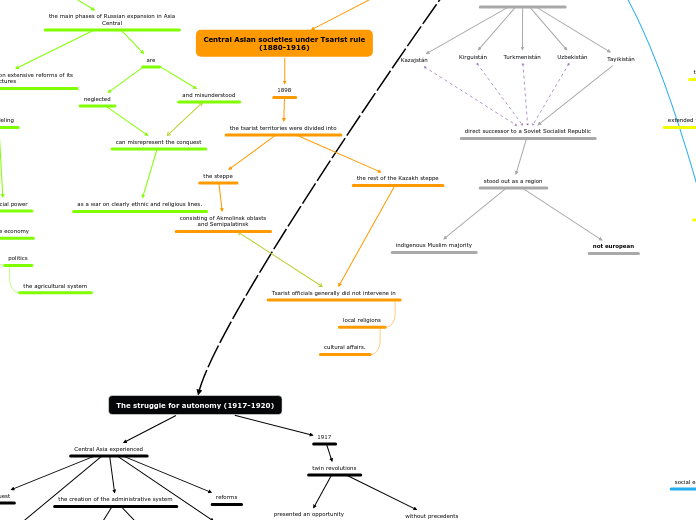HISTORY OF THE ASIA REGION
CENTRAL – 1700 TO 1991
Central Asian societies under Tsarist rule
(1880-1916)
1898
the tsarist territories were divided into
the rest of the Kazakh steppe
Tsarist officials generally did not intervene in
local religions
cultural affairs.
the steppe
consisting of Akmolinsk oblasts
and Semipalatinsk
The rebellion of 1916 and its suppression
a general rebellion against
the russian colonial regime
was brutally repressed
the immediate cause of the uprising was
a decree conscripting men to serve in the tsarist army
during World War I
the rebellion spread
to the Semirechie region
and northern Kyrgyzstan
today it spans southeastern Kazakhstan
Tsarist rule in Central Asia and Islam
Colonization under the tsars
had effects
as negative
both positive
can be attributed
Migration of Russian settlers
the colonization
the migration
were
basic features of Russian history
related
Russian migration to the Central Asian region
The mass migration of Russian peasants
the government of their Central Asian territories
Islam had experienced dark periods
Russia had some 20 million Muslim subjects.
a Muslim population larger than that of the Ottoman Empire
extended to the area of religion
Soviet rule in Central Asia (1920-1991)
period
big projects of
social engineering
or for the purpose of
create a new type modern town
in religion
Modern society
by a soviet regime
National Delimitation
the process of
establishment of national political entities
the limits between them
key element of nationality policy
during the period of the “affirmative action” strategy.
The struggle for autonomy (1917-1920)
Central Asia experienced
the conquest
modernization attempts
reforms
native revolts
the creation of the administrative system
empire collapse
rise of russian centrism
1917
twin revolutions
presented an opportunity
for those who wanted to press for the independence of the region.
without precedents
made up of five republics
Kazajstán
Kirguistán
Tayikistán
direct successor to a Soviet Socialist Republic
stood out as a region
indigenous Muslim majority
not european
Turkmenistán
Uzbekistán
Tsarist expansion into Central Asia: conquest and colonization (1730s–1880s)
Drivers of Tsarist Russian expansion in Central Asia
the main phases of Russian expansion in Asia
Central
are
and misunderstood
neglected
can misrepresent the conquest
as a war on clearly ethnic and religious lines.
the Russian Empire embarked on extensive reforms of its
social structures
remodeling
the judicial power
the economy
politics
the agricultural system
The conquest of Central and South Central Asia (1860s–1880s)
Peter the Great's attempts to conquer Uzbekistan
ended in disaster
States of the region
politically divided
were weakened by conflict and internal disharmony
an impoverished land
the Central Asian steppe
was largely controlled by the Kazakh Khanate
in 1718
from the 1730s
the rulers of the Kazakh Zhuzes
began to turn to the Russian Empire for
protection.
1860
the Khanates of Khiva
they were at war with each other
with Iran and with the northern Kazakhs.
Kokand
Bukhara Emirate
The first steps towards Russian intervention in the Central Asian region
in the Kazakh territories
Diplomatic contacts between Moscow and the Kazakh people are recorded
in the 1570s
they were resumed in 1594
to conclude agreements with the Russian government on a
topic series
including a military alliance
in the 1580s
in the border region with the Russian state
